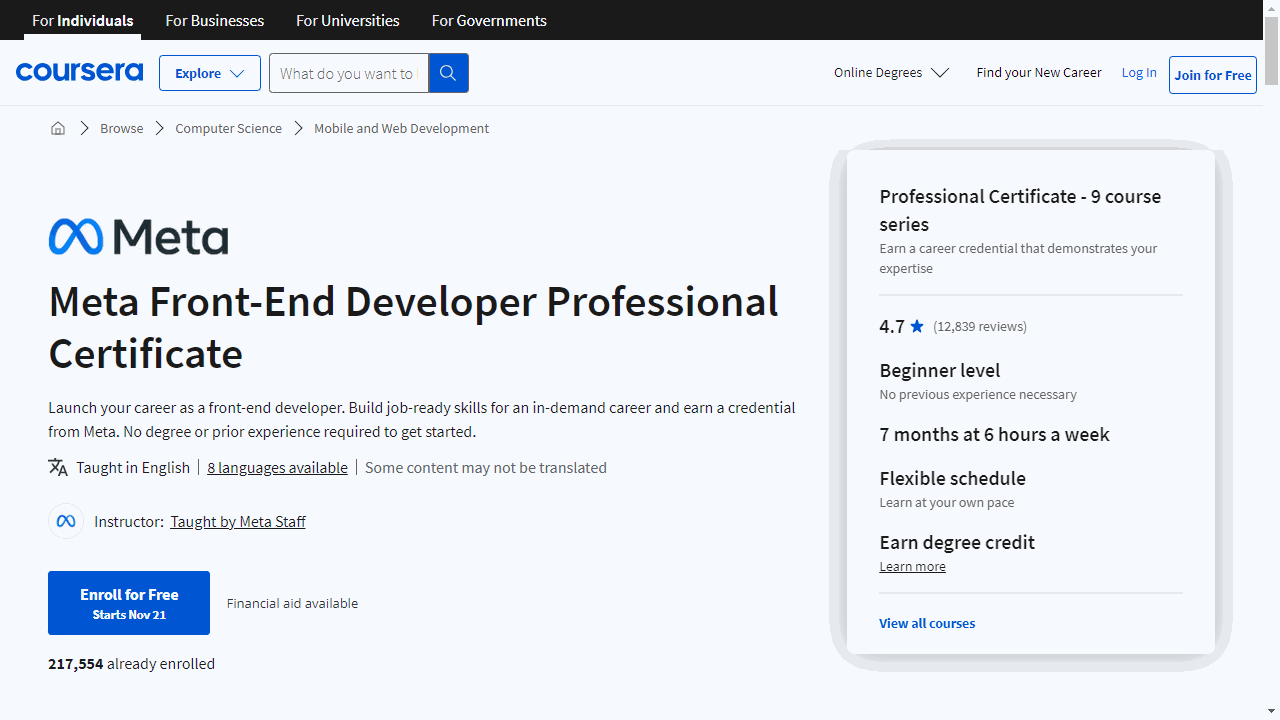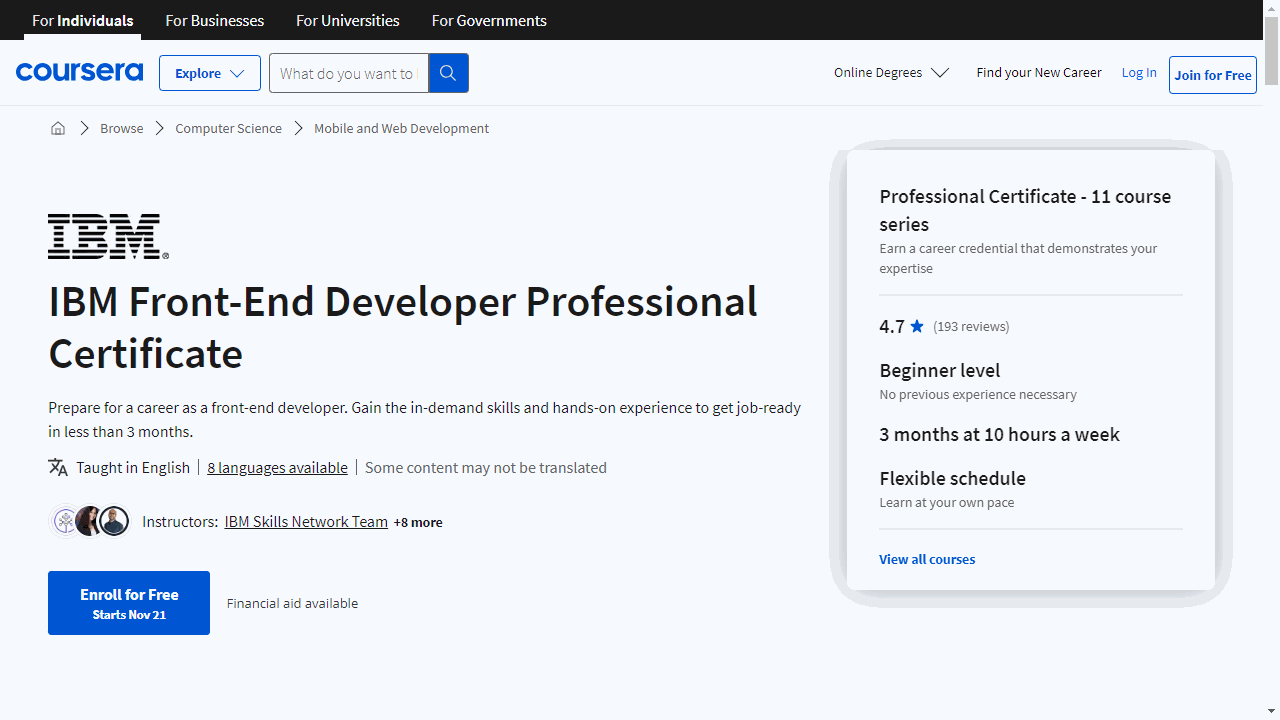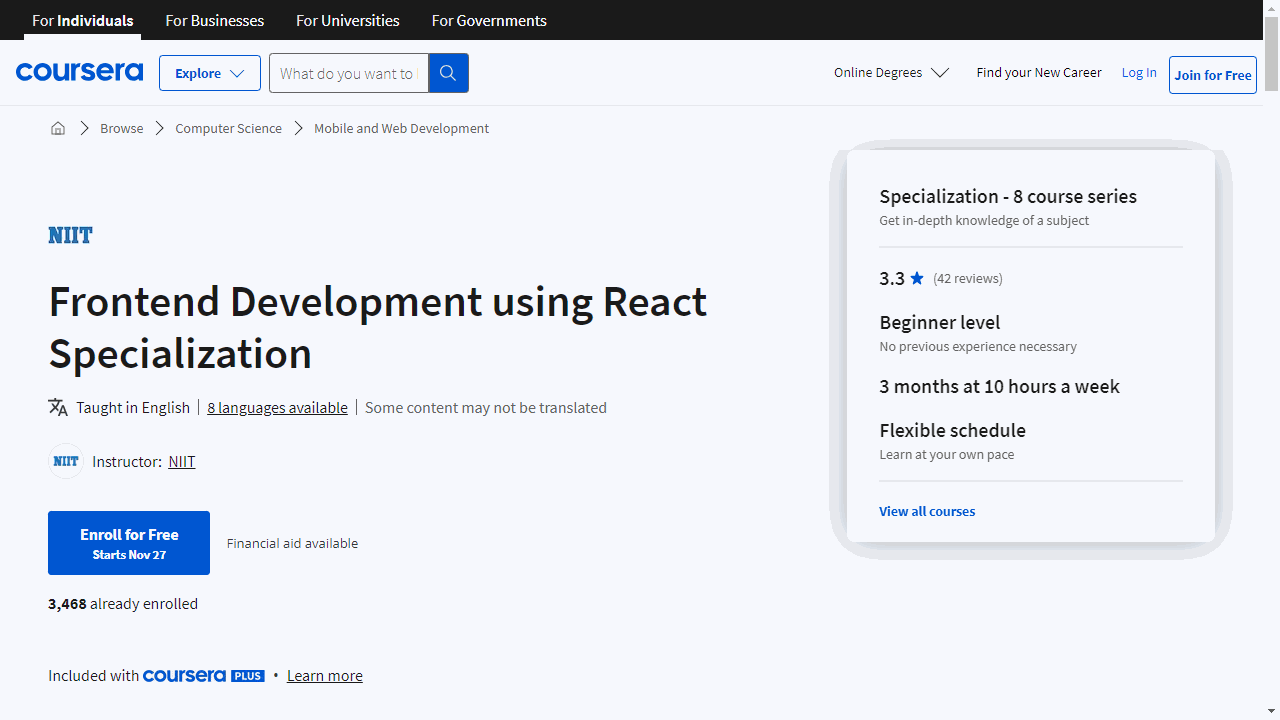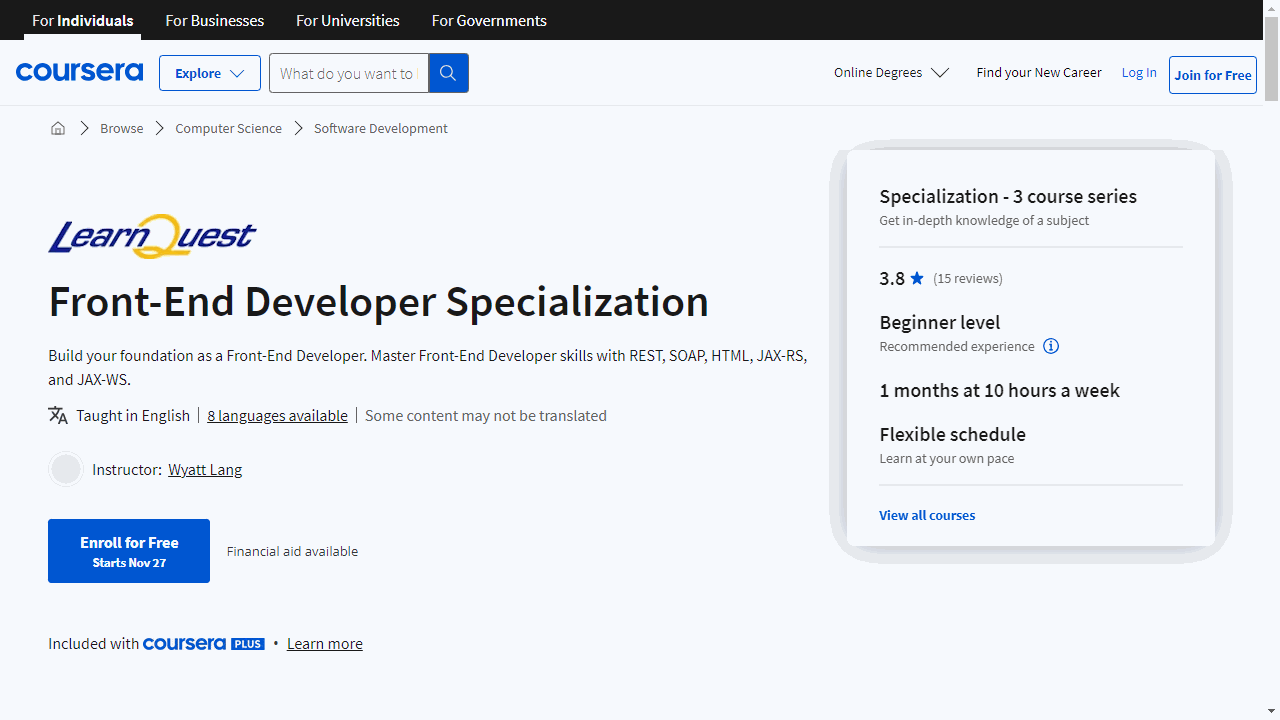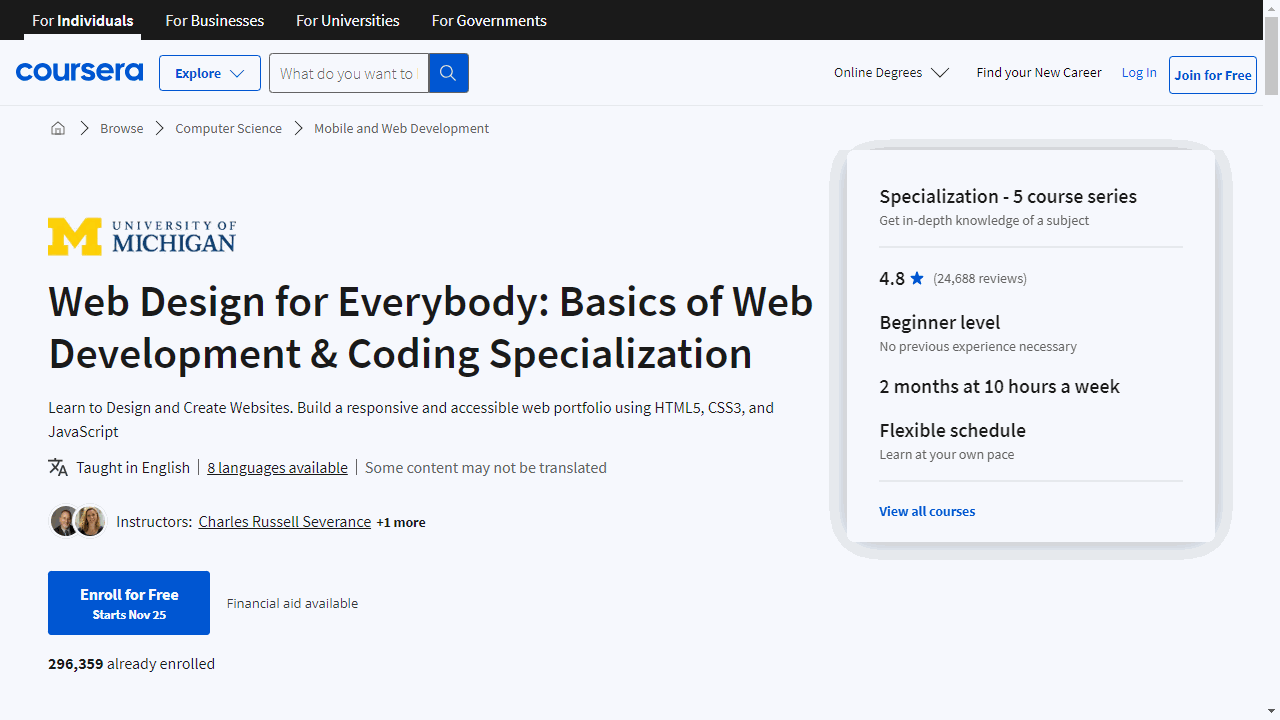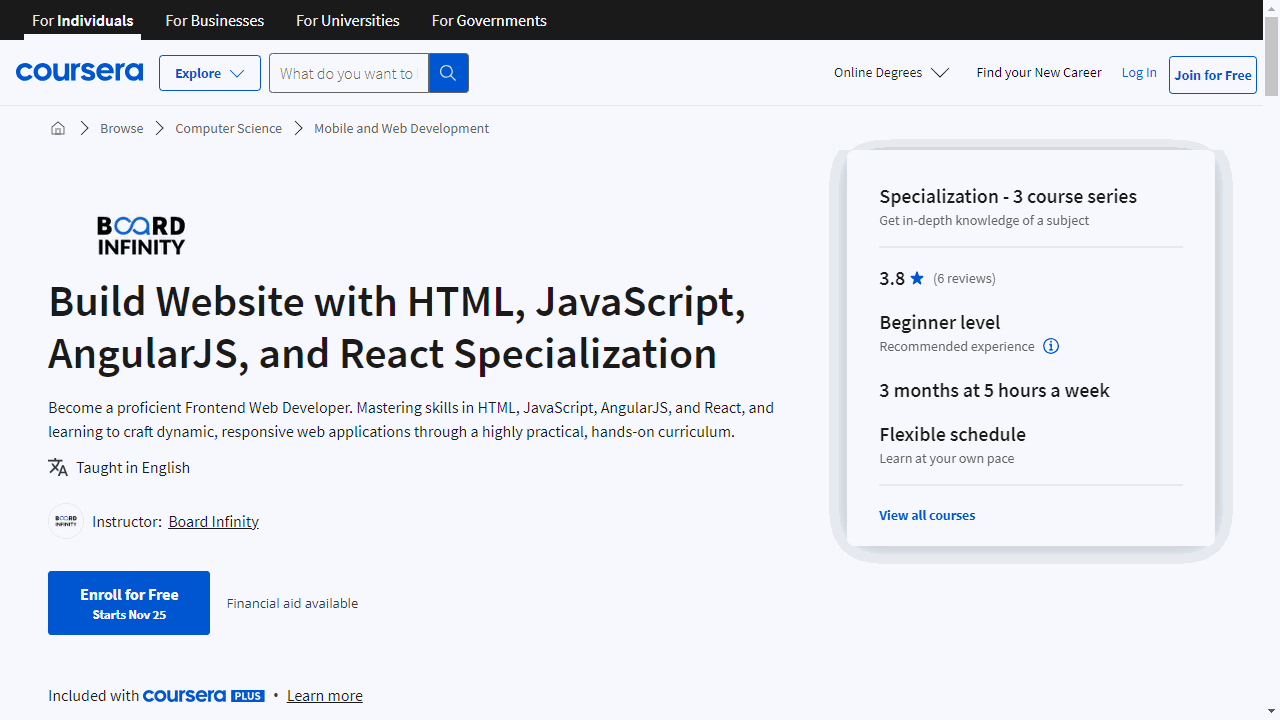Front-end development is the art of bringing websites and web applications to life.
It’s a fast-paced and dynamic field where you can create visually appealing, interactive, and user-friendly experiences.
By learning front-end development, you can build websites and applications, contribute to teams, and potentially even launch your own career in the tech industry.
Finding a high-quality front-end development course on Coursera can be a challenging task.
You’re looking for a program that’s comprehensive, engaging, and taught by industry experts, but also tailored to your learning style and goals.
It’s a journey that requires patience and dedication, but the rewards are immense.
For the best front-end development course overall on Coursera, we recommend the Meta Front-End Developer Professional Certificate.
This program provides a comprehensive curriculum that takes you from beginner to job-ready.
You’ll learn essential technologies like HTML, CSS, JavaScript, and React, as well as key skills like version control with Git and responsive design.
The program is structured to be flexible and self-paced, allowing you to learn at your own speed.
While this program is our top pick, there are other excellent options available.
Keep reading to discover more recommendations, tailored to different skill levels, interests, and career goals.
Meta Front-End Developer Professional Certificate
Begin with “Introduction to Front-End Development,” where you’ll learn the essentials of web development.
You’ll start by crafting simple webpages with HTML and styling them with CSS.
The course introduces you to Bootstrap and React, equipping you with the tools to create user-friendly interfaces.
Progress to “Programming with JavaScript,” where the focus is on the language that brings websites to life.
You’ll gain hands-on experience with JavaScript essentials and learn to test your code effectively using Jest, setting a strong foundation for interactive web development.
“Version Control” is crucial for any developer working in a team.
This course teaches you how to use Git and GitHub for collaboration, ensuring that managing and revising code becomes second nature to you.
In “HTML and CSS in depth,” you’ll refine your design skills, learning advanced styling techniques and responsive design with Bootstrap.
Debugging is also covered, teaching you to identify and fix common front-end issues.
“React Basics” introduces you to the popular JavaScript library for building user interfaces.
You’ll learn to manage data and create dynamic elements, culminating in the development of a React application.
For those looking to deepen their React knowledge, “Advanced React” delves into more complex concepts.
You’ll explore hooks, state management, and component composition, enhancing your ability to build sophisticated applications.
The “Principles of UX/UI Design” course is where design meets functionality.
You’ll learn to empathize with users, design with intention, and prototype your ideas using Figma, ensuring your creations are both attractive and user-centric.
The “Front-End Developer Capstone” project is where you’ll apply everything you’ve learned.
You’ll build an application that demonstrates your skills in React and responsive design, resulting in a portfolio piece to impress potential employers.
Lastly, “Coding Interview Preparation” gets you ready for the job market.
You’ll polish your problem-solving skills, understand data structures and algorithms, and learn strategies for successful technical interviews.
Each course is designed with beginners in mind, requiring no prior development experience—just a willingness to learn and basic internet skills.
IBM Front-End Developer Professional Certificate
The journey begins with “Getting Started with Front-End and Web Development,” a course that lays a solid foundation for beginners.
You’ll learn the essentials of UI/UX design and use tools like WordPress to create interactive websites, all without requiring any previous programming knowledge.
Moving on, “Introduction to Software Engineering” broadens your understanding of the software development process.
It covers the Software Development Lifecycle (SDLC), Agile, and Scrum methodologies, and introduces you to programming with Python.
This course is particularly valuable as it aligns with the industry’s rapid growth and demand for skilled professionals.
For those interested in design, “Designing User Interfaces and Experiences (UI/UX)” focuses on the principles of creating user-friendly interfaces.
You’ll engage with visual design concepts and practical tools like Figma, equipping you with the skills to craft appealing and intuitive user experiences.
“Introduction to HTML, CSS, & JavaScript” is where you’ll get to grips with the core languages of web development.
By the end of this course, you’ll have the skills to build websites that are not only visually appealing but also interactive, enhancing the user experience.
In “Developing Websites and Front-Ends with Bootstrap,” you’ll learn to use the Bootstrap framework to create responsive and consistent websites.
This course is practical, providing you with the opportunity to apply Bootstrap to real-world projects.
“Getting Started with Git and GitHub” introduces you to the essentials of code collaboration and version control.
These skills are crucial for working effectively in team environments and are highly valued by employers.
“Developing Front-End Apps with React” teaches you how to create sophisticated web applications using React.
This course is for those looking to stay ahead in the front-end development field, as React is a sought-after skill in the industry.
“Intermediate Web and Front-End Development” goes beyond the basics, delving into SEO, build tools like Webpack, and debugging techniques.
These skills are key to optimizing websites for performance and search engine rankings.
“Get Started with Cloud Native, DevOps, Agile, and NoSQL” covers the latest trends in software development, including cloud-native applications and Agile practices.
This course ensures you’re familiar with the modern development ecosystem and the tools that support it.
The “Front-End Development Capstone Project” is where you’ll apply everything you’ve learned by building a responsive website.
This project not only solidifies your skills but also serves as a showcase piece for potential employers.
Lastly, “Software Developer Career Guide and Interview Preparation” prepares you for the job market.
It offers practical advice on crafting a resume, building a portfolio, and navigating interviews, giving you the tools to present yourself effectively to employers.
Frontend Development using React Specialization
This specialization is a comprehensive path to becoming proficient in React JS, offering a blend of foundational knowledge and advanced techniques.
The journey begins with “Introduction to building Web Pages using HTML5 and CSS3,” where you’ll grasp the fundamentals of structuring and styling web pages.
It’s the foundation you need to create content that’s both visually appealing and accessible.
As mobile browsing dominates, “Developing Responsive Web Pages Using HTML5 and CSS3” ensures your designs look great on any device.
You’ll learn to use modern CSS and Bootstrap to craft responsive layouts that adapt seamlessly to different screens.
Interactive elements are crucial for user engagement, and “Building Interactive Web Pages Using Modern JavaScript” equips you with JavaScript skills to animate and enliven your web pages.
This course is your stepping stone to creating dynamic content that captivates users.
React’s power comes to the forefront in “Building Interactive User Interfaces Using React Library.”
Here, you’ll delve into Single Page Applications (SPAs) and React Class components, learning to build fast, responsive, and navigable user interfaces.
“Building User Interfaces Using Functional React Components” introduces a modern approach with functional components and React Hooks.
This course focuses on enhancing code readability and reusability, ensuring your applications are efficient and maintainable.
In “Building High Quality User Experience Using Material UI,” you’ll discover how to leverage Material UI and CSS-in-JS to design visually stunning and user-friendly interfaces.
This course is all about elevating the aesthetic and functional quality of your applications.
“Building Navigational Workflows Using React” tackles the intricacies of form creation and navigation within your applications.
You’ll get hands-on with React forms, Formik, and React Router, learning to build intuitive and complex workflows.
The “Capstone Project” is where you apply your newfound knowledge to a practical challenge, synthesizing the skills you’ve developed to produce a project that adheres to professional standards.
Front-End Developer Specialization
The specialization begins with “RESTful Web Services with JAX-RS,” where you’ll grasp the essentials of enterprise applications.
This course isn’t just about absorbing information; it’s about applying it.
You’ll learn to construct RESTful services using JAX-RS, manage exceptions, and refine your services with Interceptors and Filters.
Your new skills in Enterprise Software, Java, and using Curl will be immediately applicable in real-world scenarios.
Moving on, “SOAP Web Services with JAX-WS” deepens your understanding of web services.
Here, you’ll unravel the complexities of JAX-WS, SOAP, and XML.
The course emphasizes practical application, guiding you through creating JAX-WS endpoints and clients.
You’ll leave with a solid command of Java and SOAP, tools that are crucial for robust web service development.
Lastly, the “HTML - Front-End Developer” course lays the foundation of your front-end expertise.
HTML is the bedrock of web content, and this course ensures you’re well-versed in it.
Through interactive labs, you’ll learn to craft web pages that are both functional and visually engaging.
This hands-on approach solidifies your HTML knowledge, preparing you to tackle front-end challenges with ease.
Each course in this specialization is designed to be interactive and practical, ensuring that you don’t just learn, but also apply your knowledge.
Web Design for Everybody: Basics of Web Development & Coding Specialization
Starting with “Introduction to HTML5,” you’ll grasp the essentials of web structure, learning to create pages with text, links, and images.
It’s a practical first step, ensuring you understand the building blocks of web content.
Next, “Introduction to CSS3” teaches you to style your web pages.
You’ll learn to write CSS rules that control layout, fonts, and colors, transforming basic HTML into visually appealing designs.
The course emphasizes accessibility, ensuring your designs are usable by all.
“Interactivity with JavaScript” introduces you to dynamic web development.
You’ll explore JavaScript basics, from variables to functions, and use the DOM to make your pages respond to user actions.
The course culminates in building an interactive form, a skill crucial for engaging websites.
“Advanced Styling with Responsive Design” is where your skills expand to accommodate the diverse range of devices used to access the web today.
You’ll tackle mobile-first design and learn to use media queries, ensuring your sites are flexible and accessible across all platforms.
The “Web Design for Everybody Capstone” is the final challenge, where you’ll apply your new skills to create a responsive web portfolio.
This project solidifies your learning and gives you a tangible asset to showcase your abilities.
You’ll emerge with the skills to create accessible, responsive websites, ready to tackle real-world projects.
Build Website with HTML, JavaScript, AngularJS, and React Specialization
Starting with “Build a Webpage with HTML and CSS,” you’ll grasp the essentials of web structure using HTML and enhance visual appeal with CSS.
The course simplifies complex concepts, ensuring you understand how to structure content and style web pages effectively.
Bootstrap training is included, equipping you with the skills to create responsive designs that adapt to different devices.
Moving on to “JavaScript for Web Development,” you’ll delve into the language that adds interactivity to websites.
The course covers everything from JavaScript basics to the Document Object Model (DOM), enabling you to manipulate web pages in real-time.
You’ll also learn jQuery, which simplifies code and accelerates development, allowing you to implement dynamic features with ease.
The final course, “Libraries and Frameworks for Frontend Development,” introduces you to the powerhouses of modern web development: React and Angular.
You’ll explore React’s efficient UI design and Angular’s scalable application structure.
The course culminates in a project that combines these technologies, showcasing how they can work together to create sophisticated web applications.
By the end of the specialization, you’ll have a solid foundation in web development, equipped with the skills to build responsive, interactive websites.
Also check our posts on:
